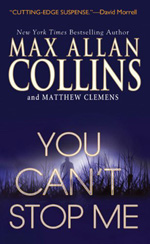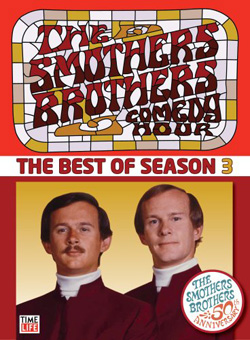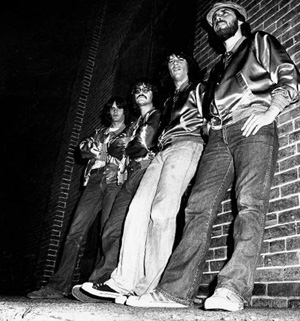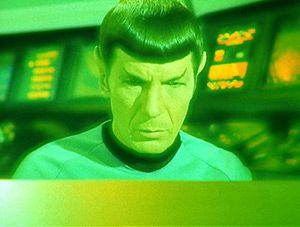Last week was spent recovering from writing KISS HER GOODBYE. I really should allow myself a week off between projects, but I am stacked up right now and just can’t take the luxury. But it was slow-going, getting anything done. By late in the week I was finally able to finish a 14-page synopsis for the next Mike Hammer radio novel, which is entitled ENCORE FOR MURDER. The basis is a brief novel outline I found in Mickey Spillane’s files, so THE NEW ADVENTURES OF MIKE HAMMER VOL. 3 (starring Stacy Keach) will again have a basis in Mickey’s work.
I also wrote the introduction for volume ten of IDW’s reprint series of the DICK TRACY strip, edited by my old pal Dean Mulaney, the man who brought MS. TREE to the world of comics. The book winds up 1945, includes the entire run of 1946, going several months into ‘47. This is prime Gould material — great villains, lots of wonderful comic-relief characters, with everything from the intro of the Two Way Wrist Radio to the marriage of B.O. Plenty and Gravel Gertie. Watch for that — it’s one of Gould’s strongest periods.
 The first review of YOU CAN’T STOP ME has appeared, from internet reviewer Harriet Klauser, and it’s a nice one.
The first review of YOU CAN’T STOP ME has appeared, from internet reviewer Harriet Klauser, and it’s a nice one.
I have been in a somewhat nostalgic mood lately, primed by reading a good book, DANGEROUSLY FUNNY: THE UNCENSORED STORY OF “THE SMOTHERS BROTHERS COMEDY HOUR,” by David Bianculli. It’s as entertaining as it is informative, though the author has a bad habit of repeating himself (how many times do I have to be told that Jennifer Warren became Jennifer Warnes?) and sometimes including personal asides (don’t you hate writers who do that? I do!).
Anyway, it prompted me to look at the two seasons of THE SMOTHERS COMEDY HOUR available — actually these are BEST OF’s, selected and edited by Tommy Smothers himself. Season Three, the final season, was released first, followed by Second Two (no sign of Season One yet). This is not Tommy Smothers being quirky, rather realistic. The show began as a fairly traditional comedy/variety hour in 1967, and as the times changed, and the under-thirty crowd got radicalized, the show shifted naturally. By the third season, it was featuring counter-culture musical artists (The Doors, The Who) and hip comedy (George Carlin, Jackie Mason, the Second City-style Committee) with a number of episodes performed in the round. The third season set includes an excellent documentary, SMOTHERED, which chronicles the war between the show (in particular the volatile Tom Smothers) and CBS.
I started with Season Two, and admit to being shocked by how standard a variety show it mostly was — later I learned that Tom Smothers had edited both seasons ruthlessly (sometimes too ruthlessly) because he too realized the memory of the ground-breaking show of over 40 years ago was better than the reality. That, of course, is why he insisted the final season be released first. This is not to say there isn’t a lot of funny material in the second season boxed set — the Pat Paulson run for the president is there, and Paulson was an excellent deadpan comedian. But I fast-forwarded through about a third of the stuff. Leigh French as Goldie O’Keefe, spaced-out hippie chick, remains a lovely young woman, frozen in video amber, with a nice delivery, but the “jokes” run mostly to slipping drug references past un-hip censors. If hearing the word “roach” or “high” tickles your funny bone, you’re in the right place.
TV variety shows of the fifties, sixties and even seventies were pretty dismal. I watched a lot of them as a kid, but they are a tough go to sit through now. Even shows that were hip for their era, like SMOTHERS BROTHERS, FLIP WILSON, and LAUGH-IN, seem about as dated as kinescopes of early TV.

The Smothers Brothers Comedy Hour:
Best of Season 3 


The third season of SMOTHERS was a revelation, though — while some traditional variety show stuff survives (and Tom S. edited a lot of that out), there is plenty of social commentary and musical acts that could have appeared no where else on primetime TV of the late ‘60s. I find myself not liking the stuff I didn’t like at the time — Mason Williams’ classical gas remains gaseous to me, as does his anti-censorship poem, and self-righteous hippie show biz types like the aforementioned Warnes, the Los Angeles cast of HAIR, Joan Baez and the oh so precious Donovan still give me a pain. If you lived through those years, and were a sort of hippie yourself (and that’s how I’d describe myself then — a sort of hippie, married and going to school but long-haired, in a rock band, and desperately trying not to get drafted), you found a lot of the hippie musical stuff of the era pretty forced and artificial and terribly self-satisfied.
Nonetheless, the bravery of the Smothers Brothers to air this stuff — and to employ as writer/performers young punks like Bob Einstein (aka Super Dave Osborne), Steve Martin, and Rob Reiner — is impressive. The difference in approach and attitude between season two and three is shocking — it’s like one week the show is CAROL BURNETT, and the next week it’s SATURDAY NIGHT LIVE. Historic performances from Pete Seeger (“Big Muddy” is amazing) and Harry Belafonte (“Don’t Stop the Carnival” to footage of the ‘68 Demo Convention) are alone worth the investment, and not much fast-forwarding elsewhere is required.
At the center of it all are those underrated performers, the Smothers Brothers, hip subversives posing as white-bread American boys. I loved them from the first time I saw them on (wait for it) Jack Parr’s TONIGHT SHOW. In the midst of a lot of smug and self-important folk musicians, the Smothers Brothers came on with their lampoon version of folk that had, in its day, the impact of Andy Kaufman. Initially, Tommy just seemed to be an idiot screwing up the act. We did not know we were witnessing one of the last great traditional comedy teams in the Laurel and Hardy/Abbott and Costello/Martin and Lewis mode. And Dick Smothers was and is a genius straight man.
I had all their albums. Grew up listening to them. Saw them perform at Hot Springs, Arkansas, at a nightclub/casino (a mob operation my middle-American parents took me to), and got to speak to them both and get my first celebrity autographs. They were extremely kind to me. (I would have been, perhaps, 16.) From junior high on, my friend Jim Hoffmann and I did Smothers Brothers impressions at parties and shows — we got great laughs in the time-honored tradition of kids stealing the acts of professionals, butchering those acts, and getting undeserved giddy praise from their classmates.
During the late ‘60s, Barb and I never missed THE SMOTHERS BROTHERS on Sunday night (MISSION: IMPOSSIBLE came right after, with Leonard Nimoy in for Martin Landau at this point, Trekkies). We were married in June ‘68, Barb 19 and me 20, and the assassination of Robert Kennedy took place while we were honeymooning in Chicago. Right around this time, I took a draft physical at Des Moines, Iowa, that scared me silly, classifying me 1-A — fortunately, I eventually was re-classified 4-F. Would Barb and I have gone to Canada? Probably. So we were absolutely the target audience of THE SMOTHERS BROTHERS SHOW, but I admit that I never saw anything controversial about what I saw there, and was shocked that censorship was an issue in an era of MIDNIGHT COWBOY and ZAP COMIX.
(Yes, friends, an almost draft dodger with leftist leanings somehow became the caretaker of right-wing icons Dick Tracy and Mike Hammer.)
So watching these DVDs, I find myself experiencing various shivers of memory — delight, sorrow, embarrassment, even pride — as I watch Tom and Dick Smothers on their very important TV show take on the establishment. The stories of Tom’s battles with CBS are so much like mine with the Chicago Tribune Syndicate over DICK TRACY that it made me uncomfortable — we were both punks, and both right. We took a stand, and got fired. I said pride was one of the shivers.
I recommend the book and both DVD sets, which are loaded with special features, each episode bookended with on-air comments by a very uncensored Tom and Dick (prepared for E Entertainment reruns a while back). Anyone my age will find this compelling viewing.
M.A.C.


 The third season admittedly has the two worst stinkers in the entire STAR TREK line-up – LET THIS BE OUR LAST BATTLEFIELD, the dismal racial parable (the one where Frank Gorshin does the Riddler as half black and half white, chasing around the Enterprise his fellow scenery chewer Lou Antonio who is half white and half black) and the truly abysmal WAY TO EDEN, the hippies in outer space episode, which manages to waste Charles Napier. But the third season has also the surrealistic gem SPECTRE OF THE GUN (one of the first negative views of Wyatt Earp at the OK Corral – and with DeForest Kelley, who was in the Burt Lancaster/Kirk Douglas film version, as one of the Earps!), and possibly the three best STAR TREK episodes of all, THE EMPATH, IS THERE IN TRUTH NO BEAUTY and ALL OUR YESTERDAYS. Some of the best STAR TREK episodes feature music by George Duning, sometimes re-frying his BELL, BOOK AND CANDLE score.
The third season admittedly has the two worst stinkers in the entire STAR TREK line-up – LET THIS BE OUR LAST BATTLEFIELD, the dismal racial parable (the one where Frank Gorshin does the Riddler as half black and half white, chasing around the Enterprise his fellow scenery chewer Lou Antonio who is half white and half black) and the truly abysmal WAY TO EDEN, the hippies in outer space episode, which manages to waste Charles Napier. But the third season has also the surrealistic gem SPECTRE OF THE GUN (one of the first negative views of Wyatt Earp at the OK Corral – and with DeForest Kelley, who was in the Burt Lancaster/Kirk Douglas film version, as one of the Earps!), and possibly the three best STAR TREK episodes of all, THE EMPATH, IS THERE IN TRUTH NO BEAUTY and ALL OUR YESTERDAYS. Some of the best STAR TREK episodes feature music by George Duning, sometimes re-frying his BELL, BOOK AND CANDLE score.